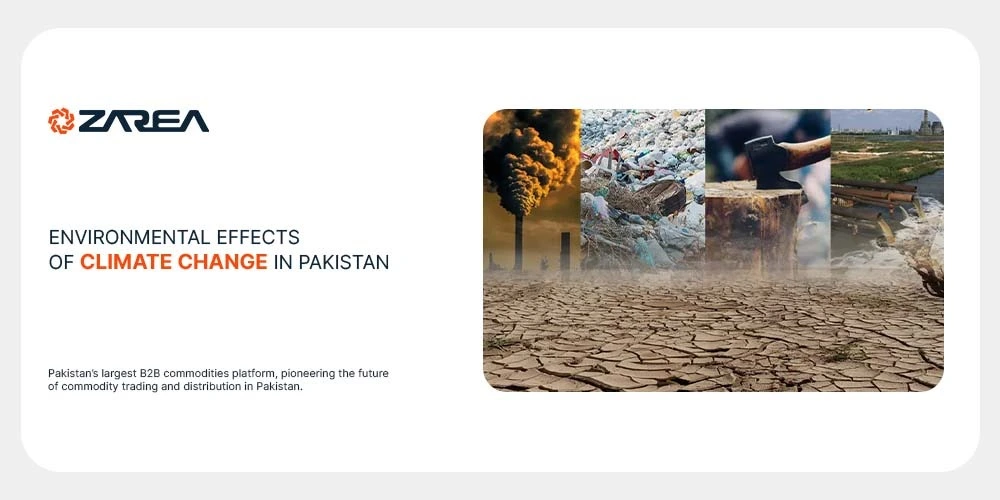Introduction – Environmental Effects of Climate Change:
Pakistan contributes less than 1% of global greenhouse gas emissions, despite being one of the 10 countries most at risk from climate change. In Pakistan, the effects of climate change are becoming more severe and are affecting public health, biodiversity, water resources, and agriculture. This synopsis identifies the most urgent problems and offers viewpoints on possible remedies.
Increasing Temperatures and Severe Weather in Pakistan:
The increase in average temperatures in Pakistan is a clear indication of climate change. Unprecedented heatwaves have struck the nation, especially in southern areas like Sindh and Balochistan. Temperature increases have resulted in decreased production, increased energy demand, and heat-related health issues.
Severe weather events like floods, droughts, and cyclones have become more common in recent years. The 2010 and 2022 floods serve as a stark reminder of climate-related disasters that caused infrastructure damage, forced millions to relocate, and caused enormous financial losses.
Impact of Climate Change on Water Resources:
Global warming is causing glaciers in Pakistan’s Hindu Kush-Himalayan region, which are essential for rivers, to recede. Water safety is now at risk due to unpredictable river currents. Irregular rainfall patterns have also caused water shortages in both urban and rural regions by hindering groundwater replenishment.
Agriculture and Food Security:
A significant percentage of the population works in the farming industry, which is extremely vulnerable to changes in the climate. Unpredictable weather events, such unexpected downpours and protracted droughts, can lower agricultural yields and jeopardise food security. These changes in the environment have had a negative impact on important crops including wheat, rice, and cotton, which has affected the nation’s total food supply as well as farmers’ profits.
Biodiversity Loss and Ecosystem Degradation:
Climate change also impacts the different ecosystems of Pakistan. Changes in temperature and precipitation have upset natural ecosystems, causing a decline in native species. Growing rates of wildfires, logging, and shifting land use all pose challenges to forest ecosystems.
Rising sea levels endanger coastal ecosystems in Sindh and Balochistan by causing erosion, increased salinity, and the destruction of mangrove forests, which are essential natural barriers against coastal floods.
Urban Environmental Challenges:
The rapid growth of metropolitan areas and climate change have worsened large cities’ environmental issues. Urban heat islands, water scarcity, and poor air quality are problems in places like Karachi, Lahore, and Islamabad. Uncontrolled construction practices and inadequate waste management worsen these environmental stressors.
Impact on Health and Migration:
A serious concern to public health is the increase of climate-related illnesses including dengue, malaria, and heat-related illnesses. Changes in the environment lead to contamination of the air and water, which puts more strain on healthcare systems. In addition, climate change-related migration is becoming more widespread. Agricultural failures, drought, or flooding compel communities to move to cities, which puts more demand on available resources and leads to unplanned city expansion.
Efforts for Mitigation and Adaptation:
Pakistan has taken a number of actions to address the consequences of climate change on the environment, such as:
- Reviving forest areas was the main goal of the Ten Billion Tree Tsunami Initiative.
- In order to encourage sustainable growth, the National Climate Change Policy was established.
- financing for renewable energy sources like wind and solar.
- construction of climate-resilient infrastructure in areas that are at risk.
- Adaptive practices are promoted through community involvement and awareness campaigns.
The Impact of Technology and Innovation:
Because they encourage the adoption of environmentally friendly building materials, facilitate effective resource management, and aid in the shift to low-carbon alternatives, digital platforms such as Zarea are essential for sustainability. Climate-adaptive techniques and precise irrigation plans are two examples of agricultural innovations that might increase resistance to climate-related problems.
Concluding Final Thoughts:
The environment of Pakistan is being significantly and intricately impacted by climate change, endangering ecosystems, people’s livelihoods, and the country’s economic destiny. Nonetheless, Pakistan can fortify its resilience and become a regional leader in sustainable development by implementing efficient policies, raising community awareness, and using technology.
Pakistan can become climate resilient by working together and using educated strategies.
FAQ’s:
What are 4 main environmental effect of climate change?
Earth’s climate is changing significantly as a result of human activity producing more greenhouse gas emissions, which has a variety of environmental repercussions. Plant and animal habitats are changing, ice on lakes and rivers is melting sooner, glaciers and ice caps are thawing, and plant and tree blossoming seasons are shifting.
How does climate change affect environmental change?
Climate change impacts the environment in many ways, including increased temperatures, rising sea levels, droughts, and flooding. These changes affect important resources and issues such as water, energy, transportation, wildlife, agriculture, ecosystems, and public health.
What are the 5 things climate is affected by?
Latitude, elevation, terrain, ocean currents, and proximity to the ocean are the five main elements that influence an area’s climate.
What are the environmental risks of climate change?
Even if we successfully lower global emissions, we will still feel the effects of climate change in our daily lives. Events like heatwaves, droughts, and flooding are happening more frequently and with greater intensity. These incidents pose serious risks to the economy and public health.
How does climate change affect the ecosystem?
Some populations may grow, decline, or even disappear as a result of climate change. These modifications may have an impact on a region’s overall biodiversity. Furthermore, when they adapt to shifting climatic circumstances, plants and animals may shift their geographic ranges.







































